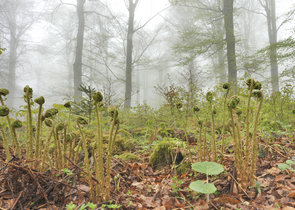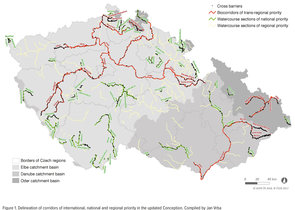Kaziranga National Park – a Little Miracle in Overcrowded India

As students, we read Zdeněk Veselovský's book ‘Voices of the Jungle’ describing his stay in Kaziranga National Park. In addition to numerous interesting facts about wildlife bionomics, the reader will find a number of notes on nature conservation half a century ago. A very valuable article on the simplest problems of biodiversity management in this Assam park was published by Douglas Chadwick in National Geographic (2010). With some worries but also hopes, we visited this area in March 2019. However, the experience exceeded our expectations, despite many problems that persist in the national park. After all, over a hundred of the symbolic Indian rhinoceros (Rhinoceros unicornis) have been poached in Kaziranga in the last ten years, and the population around the park has grown by a third.
Nature Conservation 2020 — 25. 3. 2020 — International Nature Conservation — Print article in pdf
The Elbe Canyon – Inspiration for Romantic Painters and Cradle of European Tourism

The Elbe Canyon is unique not only for its landscape and natural values, but also represents a huge potential for tourist and recreational use. While the German side realised this long ago, on the Czech side there is still an effort to transform the Elbe into an industrial transport channel. The history of tourist use of this landscape dates back to the 19th century, when one of the oldest tourist associations in Europe was established, and the Elbe Canyon became the cradle of European and world tourism together with the Alps. The fascinating landscape of Bohemian-Saxon Switzerland inspired renowned romantic artists. Today their works and later old postcards can tell us about the natural appearance of the Elbe.
Nature Conservation 2020 — 25. 3. 2020 — Focusing on the Public — Print article in pdf
Sixty Years of History of State Nature Conservation Organisations in the Czech Republic

The so-called ‘Eight’ year (2018) was significant not only for several anniversaries in Czech statehood (1918, 1938, 1948, 1968), but also for nature protection. The foundation of our oldest forest reserves, Žofín Forest (1838) and Boubín Forest (1858), was commemorated by the Year of Czech Primeval Forests.1 The anniversary of the founding of the first national professional state institution for nature conservation in 1958 remained somewhat in their shadow. After 1989, the overall preparedness of nature conservation institutions helped to enforce rapid changes in the environment and to establish modern legislation and nature conservation management in the Czech Republic.
Nature Conservation 2020 — 25. 3. 2020 — Research, Surveys and Data Management — Print article in pdf
Monitoring of Alpine Bells in the Macocha Abyss

Alpine bells (Cortusa matthioli subsp. moravica Soják) is undoubtedly one of the most famous plants of the Moravian Karst, even though very few people have ever seen it. This is because it grows in the Macocha Abyss, high on the vertical rock walls. Access to the habitat is very difficult and only possible with the help of ropes and for physically fit people with the necessary experience. Previously, part of the Alpine bells population also occurred on the debris cone at the bottom of the Abyss, from where it was first described. However, only three specimens now survive here.
Nature Conservation 2020 — 25. 3. 2020 — Research, Surveys and Data Management — Print article in pdf
Červenohorské sedlo mountain pass:

The west-east oriented main ridge of the Jeseníky Mountains is an important migration barrier for flying animals. The remarkable col of the Červenohorské sedlo mountain pass, visible from afar, allows them to cross this barrier with less effort than if they flew over the Jeseníky ridges, and it is no wonder that especially during the autumn migration a huge number of birds, bats and various groups of migratory insects are funnelled into the relatively narrow corridor of the saddle. Since 2010, this site has been used for monitoring of migratory birds, to which the monitoring of the passage of bats and selected groups of migratory insects has been added in recent years. Especially in connection with bird migration, this is currently the largest research project in the Czech Republic and is the only locality where birds can be observed under appropriate conditions during both daytime and night-time migrations.
Nature Conservation 2020 — 25. 3. 2020 — Research, Surveys and Data Management — Print article in pdf
Records of Animals Admitted to the National Network of Rescue Stations and What They Can Tell Us

The National Network of Rescue Stations project brings, in addition to thousands of saved lives of wild animals and effective information for the education of inhabitants, also interesting statistics. The central register of all animals received not only allows the monitoring of numbers of species and individuals of injured animals and the dates and locations, but also their fate – reasons why the injury occurred, time when they were admitted, number of days spent at the station, etc. Up to 57 data items can be recorded for each animal received. The long-term uniform methodology of record-keeping also enables the monitoring of these parameters over the years.
Nature Conservation 2020 — 25. 3. 2020 — Research, Surveys and Data Management — Print article in pdf
Influence of Fireworks on Birds

Fireworks evoke mixed feelings across society. Part of the population welcomes fireworks as extraordinary entertainment, whereas another part perceives such entertainment rather negatively, for various individual reasons. This article originated from the current need to assess the harmfulness of fireworks to wild birds from the perspective of their biology and the need to place specific cases within the legislative framework of Act No. 114/1992 Coll., on Nature and Landscape Protection (“ANLP”), as amended.
Nature Conservation 2020 — 25. 3. 2020 — Nature Conservation Legislation — Print article in pdf
Tree veteranisation, pollarding and girdling vs tree conservation

We are currently observing changes in the landscape at an unprecedented rate. We do not have in mind here the often mentioned impacts of climate change, but particularly the consequences of changes in land use by man. A century ago, when a third of the inhabitants of the Czech Republic still made a living from agriculture and forestry and the average farm size did not even exceed 5 hectares (Kučera 1994), the landscape was in many ways exploited more intensively, but at the same time in a much more mosaic way. At present, only a tenth of them participate in land management, while industrialised farming takes place in large, consolidated areas and the management of economically marginal areas and traditional, more labour-intensive forms of farming have been abandoned.
Nature Conservation 2020 — 25. 3. 2020 — Nature Conservation Legislation — Print article in pdf
Where is Šumava National Park heading?

I believe in an authentic internationally recognized national park, but the path to it is thorny, slow and cautious…
The hitherto maturing National Park can easily be compared to the life of a human being. Its birth was full of enthusiasm and great plans developed by fathers, mothers, uncles and aunts, grandmothers and grandfathers – and each person had a different plan. But everybody agreed that it is necessary to put the best into the child's life.
Nature Conservation 2020 — 25. 3. 2020 — Nature and Landscape Management — Print article in pdf
Update of the Conception for Unblocking the Czech River Network

This year, already a second update of the Conception for Unblocking the Czech River Network, an important water management planning document, will be completed. At present, the Czech Nature Conservation Agency is working on a proposal delineating watercourses which are primarily determined to be made passable for migration, at the same time respecting territorial and species protection.
For this reason, the length of corridors will generally increase as compared to the present situation. These will be prioritised in the subsidy policy also in future. The objective of the updated version of the document is to implement measures providing free migration to fish and other water animals in an effective and systematic way, especially on watercourses of international and national importance.
Nature Conservation 2020 — 25. 3. 2020 — Nature and Landscape Management — Print article in pdf

